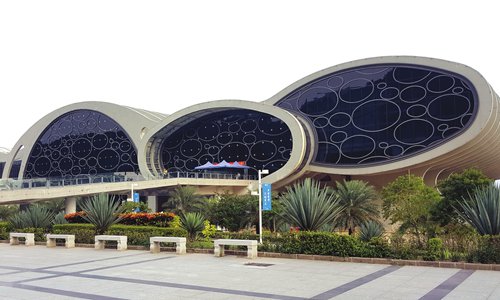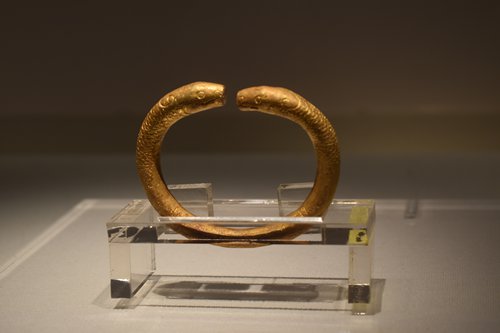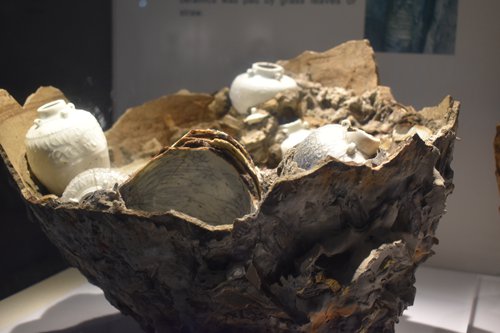HOME >> ARTS
China’s oldest shipwreck reveals secrets of Maritime Silk Road
By Chen Xi Source:Global Times Published: 2019/8/29 17:58:41

The Maritime Silk Road Museum of Guangdong in Yangjiang, South China's Guangdong Province Photo: IC

Cultural relics recovered from the Nanhai One wreckage Photo: Chen Xi/GT

Cultural relics recovered from the Nanhai One wreckage Photo: Chen Xi/GT
Standing on the beach, a huge wave-shaped museum colored with silver and dark blue colors faces the sea. Inside the museum, a mysterious and ancient shipwreck can be seen through a big glass window, waiting for archaeologists to explore its secrets.
The Maritime Silk Road Museum of Guangdong in Yangjiang, South China's Guangdong Province, is the world's first underwater archaeology museum. Inside the museum is the Nanhai One, the wreckage of a merchant vessel built during the Song Dynasty (960-1279).
"Compared with the Vasa, one of the biggest warships in the world built on the orders of the king of Sweden, Gustavus Adolphus (1594-1632), the Nanhai One site is the earliest and best preserved ancient merchant shipwrecks in the world," museum curator Zeng Chaoqun told the Global Times, going on to explain that the wreck was given the name Nanhai One because it is the first major ancient shipwreck discovered in Nanhai, or the South China Sea.
A total of 22.95 meters long and 9.85 meters wide, the wreck looks very old. Corroded by seawater, only the hull of the ship remains. Fortunately, this hull is relatively intact, so the wreck has provided archaeologists great insight into the structure of ships during that period.
Surprise discovery
"What happened to the ship and what caused it to sink? We have not found the answer. Natural disasters, like storms, are the most common causes of a shipwreck. It could also have been mishandling by the crew that caused the ship to capsize or it may have sunk from running over rocks, overloading or unbalanced placement of goods onboard the ship, or pirate attacks or even being the casualty of war," Ye Daoyang, one director of the museum, told the Global Times.
"Based on the structure of the hull, the ship was made in East China's Fujian Province. We speculated it set off from Quanzhou, Fujian Province, because it was a very developed sea port at the time," he noted.
Ye said the discovery of the Nanhai One was something of a surprise.
In August of 1987, the Maritime Exploration and Recoveries PLC, a British maritime salvage company, got permission from the Chinese government to search for the Rijnsburg, a Dutch merchant ship that sank during a typhoon in 1772. Roving the waters off the southeast coast of China, the search team did find a ship, but not the one they had expected.
In winter 1989, the National Museum of China cooperated with the Underwater Archaeology Research Institute of Japan to investigate the Nanhai One wreck. This investigation is often seen as the beginning of underwater archaeology in China, according to an introduction at the museum.
Priceless treasure
Ye said the archaeological team excavated more than 18,000 priceless cultural relics. Among the many displays at the museum, some golden relics catch the eyes of many tourists.
Under the glass showcase, three sparkling rings shine in the light. They are made up of nearly 100 percent gold. One of the two appears semi-finished as there is room to have valuable jewels inset.
"Many visitors are hooked by the three golden rings. The rings may have been further worked on in some South Asian counties like Sri Lanka during the Song Dynasty because those countries produced exquisite diamonds at that time. Some rich people from South Asian countries might custom order golden rings such as these from China and then plan to have diamonds placed in them after they are shipped back to their countries," Ye said.
In addition to the golden rings, the archaeological team also uncovered other types of artifacts including different kinds of copper coins, some porcelain cups, bowls and plates and even wooden combs.
"Many visitors wonder if women used to travel on the ship because of the wooden combs. However, this possibility is very small as it was not a cruise. In fact, the men of the Song Dynasty had long hair and they needed combs to take care of their hair," Ye explained.
"We also found DNA from foreign men from some bones and hair on the ship, which demonstrates the glorious trade that took place along the Song Dynasty's Maritime Silk Road, through which people from all over the world came to China for business," Sun Jian, chief technical supervisor of the National Center of Underwater Cultural Heritage and the leader of the Nanhai One research program, told the Global Times.
Leading the way
According to the museum, the Nanhai One is one of the most representative cultural icons of the Maritime Silk Road as it boasted the largest number of cultural relics ever discovered from a wreckage at sea.
"The Chinese government has started to pay attention to maritime archaeology. The Nanhai One is the leader in the field in China," Zeng said, noting that the museum will cooperate with other institutions around the world, such as the British Museum, to hold overseas exhibitions.
"We plan to put some cultural relics from the shipwreck on display in museums abroad so more people can get to know the story of the ship. We also want to create some cultural and creative industries related to the Nanhai One to attract more people to visit Yangjiang, which will boost the local tourism industry," Zeng said.
Newspaper headline: Story from under the sea